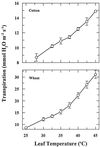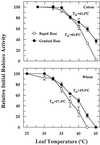Inhibition and acclimation of photosynthesis to heat stress is closely correlated with activation of ribulose-1,5-bisphosphate Carboxylase/Oxygenase
- PMID: 10318695
- PMCID: PMC59249
- DOI: 10.1104/pp.120.1.173
Inhibition and acclimation of photosynthesis to heat stress is closely correlated with activation of ribulose-1,5-bisphosphate Carboxylase/Oxygenase
Abstract
Increasing the leaf temperature of intact cotton (Gossypium hirsutum L.) and wheat (Triticum aestivum L.) plants caused a progressive decline in the light-saturated CO2-exchange rate (CER). CER was more sensitive to increased leaf temperature in wheat than in cotton, and both species demonstrated photosynthetic acclimation when leaf temperature was increased gradually. Inhibition of CER was not a consequence of stomatal closure, as indicated by a positive relationship between leaf temperature and transpiration. The activation state of ribulose-1,5-bisphosphate carboxylase/oxygenase (Rubisco), which is regulated by Rubisco activase, was closely correlated with temperature-induced changes in CER. Nonphotochemical chlorophyll fluorescence quenching increased with leaf temperature in a manner consistent with inhibited CER and Rubisco activation. Both nonphotochemical fluorescence quenching and Rubisco activation were more sensitive to heat stress than the maximum quantum yield of photochemistry of photosystem II. Heat stress led to decreased 3-phosphoglyceric acid content and increased ribulose-1, 5-bisphosphate content, which is indicative of inhibited metabolite flow through Rubisco. We conclude that heat stress inhibited CER primarily by decreasing the activation state of Rubisco via inhibition of Rubisco activase. Although Rubisco activation was more closely correlated with CER than the maximum quantum yield of photochemistry of photosystem II, both processes could be acclimated to heat stress by gradually increasing the leaf temperature.
Figures








References
-
- Andrews TJ, Hudson GS, Mate CJ, von Caemmerer S, Evans JR, Avridsson YBC. Rubisco, consequences of altering its expression and activation in transgenic plants. J Exp Bot. 1995;46:1293–1300.
-
- Berry JA, Björkman O. Photosynthetic response and adaptation to temperature in higher plants. Annu Rev Plant Physiol. 1980;31:491–543.
-
- Bilger W, Schreiber U, Lange OL. Chlorophyll fluorescence as an indicator of heat induced limitation of photosynthesis in Arbutus unedo L. In: Tenhunen JD, Catarino FM, Lange OL, editors. Plant Responses to Stress. Berlin: Springer; 1987. pp. 391–399.
-
- Brooks SPG. A simple computer program with statistical tests for the analysis of enzyme kinetics. BioTechniques. 1992;17:1154–1161. - PubMed
LinkOut - more resources
Full Text Sources

